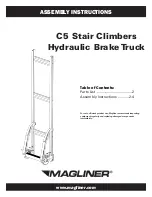
© 2018 Pierce Manufacturing Inc. All Rights Reserved.
Safety and Responsibility / 2-7
SAFETY
2-2.
Backing the Vehicle
According to the National Safety Council, one out of four vehicle accidents can be blamed on poor backing
techniques. The use of safe vehicle backing practices can help prevent injury or death to those around you.
•
Get to know your vehicle's blind spots. In a medium-sized truck, blind spots can extend up to 16 feet in front and
160 feet behind a vehicle. Use a helper who can walk around your vehicle while it is parked to get to know when
you can see them and when you can not. Remember that mirrors can never give the whole picture while
backing.
•
Think in advance. Whenever possible, avoid situations where you will need to back up.
•
Park Defensively. Choose easy-exit parking spaces that don't crowd neighboring vehicles. Park in the center of
the parking space. If parking in an alley, back into it so you are pulling forward onto the street when you leave.
•
Do a walk-around before backing. Check for people, children, or obstructions in the area. Check for soft soil,
potholes, tire hazards, low hanging trees or power lines, or other dangers.
•
Use a spotter to assist when backing. The driver and spotter should use hand signals instead of verbal ones
and make sure they understand each other's signals. Don't have the spotter walking backwards while giving
instructions.
•
If spotting for yourself, return to the vehicle and start backing within a few seconds after finishing the walk-
around. This will allow very little time for people and or obstacles to change behind the vehicle. Only back
without a spotter after gaining as much information as possible about what is behind you.
•
Back-up alarms will help warn away pedestrians and drivers of other vehicles who may try to enter the area your
vehicle is backing into. Always listen to be sure that your back-up alarm is working before proceeding
backwards.
•
No amount of forward driving experience will help you with backing a truck. You must practice in a safe area
until you become familiar with the way your vehicle backs up compared to the direction the steering wheel is
turned.
2-3.
Vehicle Handling Characteristics
Safe operation of any vehicle is the responsibility of the driver. Heavy trucks have a significantly higher rollover
tendency than other types of vehicles, due to a higher center of gravity. To reduce the risk of rollover, avoid making
sharp turns at excessive speeds and other abrupt maneuvers. In the event of a rollover crash, an unbelted person
is significantly more likely to become injured or die than a person wearing a seat belt. Unbuckled occupants can also
become a hazard to other occupants as they may be thrown around inside the cab in the event of a crash.
ALWAYS
BUCKLE UP.
Backing Hazard.
Ensure that personnel are clear before driving in reverse.
Always use a spotter when backing.
Backing vehicle without knowing what is behind you may injure or kill.
Summary of Contents for Enforcer
Page 1: ... 2018 Pierce Manufacturing Inc Part No PM C OM014 SEN 0718 Operator s Manual Saber Enforcer ...
Page 2: ......
Page 18: ...FOREWORD 1 6 To the Owner and Operator 2018 Pierce Manufacturing Inc All Rights Reserved ...
Page 30: ...SAFETY 2 12 Safety and Responsibility 2018 Pierce Manufacturing Inc All Rights Reserved ...
Page 122: ...OPERATION 5 60 Driving the Vehicle 2018 Pierce Manufacturing Inc All Rights Reserved ...
Page 184: ...A 4 2018 Pierce Manufacturing Inc All Rights Reserved ...





































